Today marks the 75th Anniversary of the third day of Operation Argument otherwise known as BIG WEEK. On Tuesday, February 22, 1944 the 15th Air Force went after the Luftwaffe in the skies over Germany — with the 8th Air Force operations being heavily disrupted by fog — in the battle for air superiority before the Normandy invasion scheduled for June 1944.
The idea for Operation Argument was to force the Luftwaffe fighter force to fight by attacking targets they had to defend — the German aircraft industry — with fighter escorted bombers.
The 15th Air Force attacked without fighter escorts.
Oops.
These were the results of the 3rd day of combat —
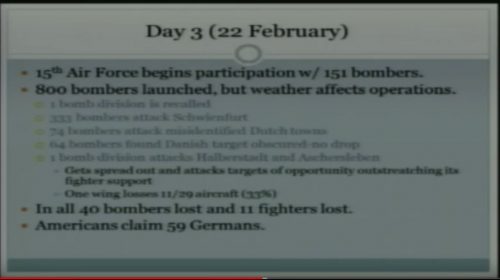
ETO Strategic Operations
Mission 230: “Big Week” continues with 799 aircraft dispatched against German aviation and Luftwaffe airfields; 41 bombers and 11 fighters are lost.
- 289 B-17s are dispatched against aviation industry targets at Aschersleben (34 bomb), Bernburg (47 bomb) and Halberstadt (18 bomb) in conjunction with a Fifteenth Air Force raid on Regensburg, Germany; 32 hit Bünde, 19 hit Wernigerode, 15 hit Magdeburg, 9 hit Marburg and 7 hit other targets of opportunity; they claim 32-18-17 Luftwaffe aircraft; 38 B-17s are lost, 4 damaged beyond repair and 141 damaged; casualties are 35 KIA, 30 WIA and 367 MIA.
- 333 B-17s are dispatched to Schweinfurt but severe weather prevents aircraft from forming properly and they are forced to abandon the mission prior to crossing the enemy coast; 2 B-17s are damaged.
- 177 B-24s are dispatched but they are recalled when 100 miles (160 km) inland; since they were over Germany, they sought targets of opportunity but strong winds drove the bombers over The Netherlands and their bombs hit Enschede, Arnhem, Nijmegen and Deventer; they claim 2-0-0 Luftwaffe aircraft; 3 B-24s are lost and 3 damaged; casualties are 30 MIA. About 900 civilians were killed, mainly in the bombing of Nijmegen. In 1984, the book De Fatale Aanval (“The Fatal Attack”), was written about this by eyewitness Alphons Brinkhuis, who was a 10-year-old boy at Enschede when it happened.
These missions are escorted by 67 P-38s, 535 Eighth and Ninth Air Force P-47s, and 57 Eighth and Ninth Air Force P-51s; the P-38s claim 1 Luftwaffe aircraft destroyed, 1 P-38 is damaged beyond repair and 6 are damaged; the P-47s claim 39-6-15[clarification needed] Luftwaffe aircraft, 8 P-47s are lost and 12 damaged, 8 pilots are MIA; the P-51s claim 19-1-10 Luftwaffe aircraft, 3 P-51s are lost and 3 damaged, 3 pilots are MIA.
MTO Strategic Operations
B-17s attack Petershausen marshaling yard and Regensburg aircraft factory in Germany and the air depot at Zagreb, Yugoslavia; a large force of B-24s hits Regensburg aircraft plants about the same time as the B-17 attack; other B-24s pound the town of Sibenik and the harbor at Zara, Yugoslavia; they claim 40 Luftwaffe aircraft destroyed; 13 bombers are lost.
For extensive background, see this Wikipedia article, where the passage above came from:
https://en.wikipedia.org/wiki/Big_Week
Exposing the Bomber General Lies in the “P-51 Narrative”
For all the good that the P-47 Thunderbolt did in Europe’s strategic bombing offensive, it has been written out of the victory narrative for a lot of political reasons. Political reasons starting with answering for the 26,000 men who died in the 8th Air Force in WW2 because of the flawed doctrines of the the USAAF Bomber Generals. A number of combat deaths that is larger than the entire US Marine Corps in World War 2 from Pearl Harbor to Hiroshima.
I’ve written expansively on how these flawed doctrines affected the development of auxiliary drop tank technology, the escort fighters that used them and the bomber escort doctrine that knit them together over the years on Chicagoboyz, See these posts:
History Friday — MacArthur’s Fighter Drop Tanks
Posted by Trent Telenko on July 12th, 2013
https://chicagoboyz.net/archives/37362.html
History Friday: Deconstructing the P-51 Mustang Historical Narrative
Posted by Trent Telenko on September 27th, 2013
https://chicagoboyz.net/archives/38801.html
History Friday — Revisiting the P-51 Mustang Historical Narrative
Posted by Trent Telenko on December 16th, 2016
https://chicagoboyz.net/archives/54434.html
Right now I’m going to show you how Generals Arnold, Spaatz, Anderson and the rest of the “Bomber General Mafia” put the bad mouth on the P-47’s role in obtaining air superiority over Europe.
The P-47 Variants that Won Big Week & The Lies About Them
The 8th Air Force bomber escort doctrine deployed during Big Week required fighters with drop tanks to be used in three shifts to cover the bomber formations during
- Penetration of enemy air space,
- At the target area and
- During withdrawal
The three shift fighter escort doctrine allowed USAAF fighters to drop external fuel tanks and dog fight for 30 minutes with full engine power with German fighters, while still protecting the bombers. Enemy fighters that attacked American fighters were not attacking US bombers, and enemy pilots dying in such fights did not come back to kill anything.
During the first three days of Big Week the numerical fighter composition of the “Target” or “Deep Escort” shift of the escort doctrine — since the P-38 and P-51 were used 100% in the “Deep” missions — looked something like as follows:
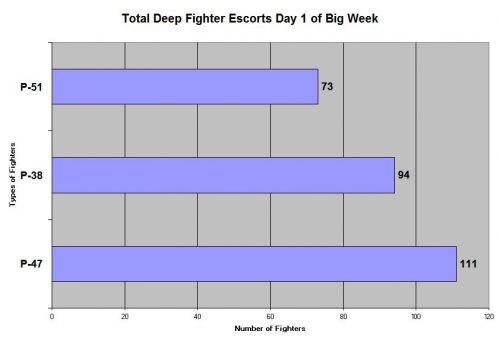
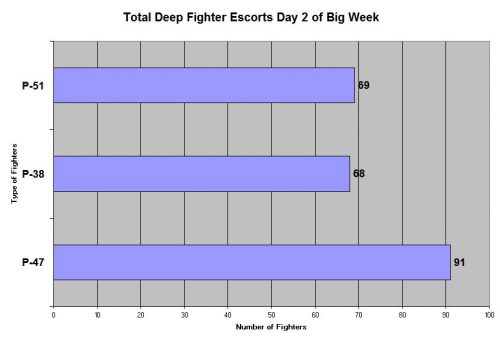

The lie the Bomber Generals planted on the P-47’s reputation was that it was too short ranged to make it to the deep bomber targets and that the P-51 flying that deep escort mission was what broke the Luftwaffe’s back. This “P-51 Narrative” absolved them of the Bomber Generals of accountability for their failed doctrines and poor decisions prior to the P-51’s arrival.
And as a political strategy, it worked. These maps were how they did it.
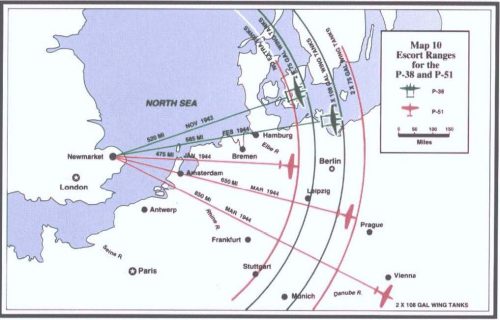
The map above came from the following report: “EIGHTH AIR FORCE TACTICAL DEVELOPMENT AUGUST 1942-MAY 1945” It was prepared by Eighth Air Force and Army Air Forces Evaluation Board.

When you do a close up of the P-47 range map you see this:
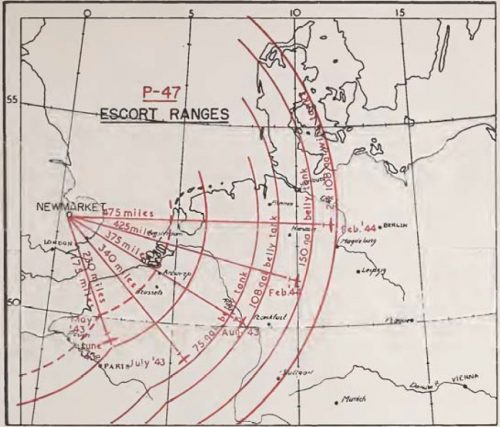
When you look closely at the escort radius map above, what you -DO NOT- see is the range of a P-47 with a pair of 150 gallon drop tanks. Nor do you see a range for a P-47 with a pair of 108 gallon wing tanks an a belly 75 Gallon tank. Nor do you see the P-47 with a pair of 108 gallon wing tanks and a 150 gallon belly tank.
P-47s were flown with all three combinations. None were in that P-47 escort radius map shown above.
See the next three photos:
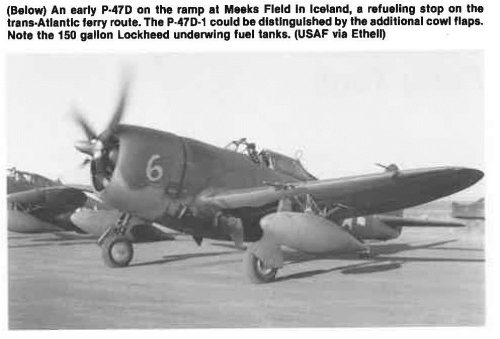
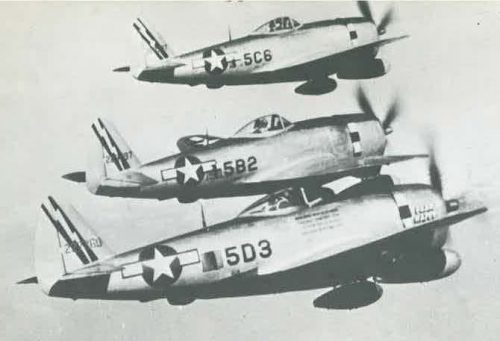
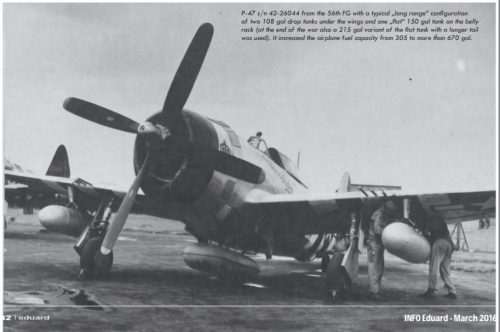
http://www.avia-it.com/act/cera_una_volta/echi/CUV_Echi_2016/Seg_art_giu_16/Drop_Tanks_USAAF.pdf
When you pull up the text of page 97 up in that Eighth Air Force and Army Air Forces Evaluation Board report and closely, you find the following:
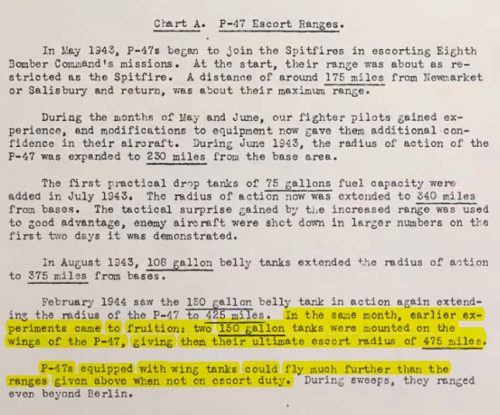
So you see in the text above that one unspecified P-47 variant with a single belly 150 gallon wing tanks reach 430 miles as an bomber escort. Another unspecified P-47 variant with a pair of 150 gallon tanks could escort to 475 miles. And a final unspecified P-47 variant could range beyond Berlin when engaged in fighter sweeps ahead of a bomber stream with a pair of 150 gallon tanks.
So…which P-47s were the Bomber Generals talking about?
Not All P-47Ds Are Created Equal
There were a lot of different P-47D variants used in the Combined Bomber Offensive. All the “D” variants had wings with drop tank plumbing, but not all of them had the most powerful R-2800-59 or 63 engines, “big paddle” propellers or extra internal fuel tankage that provided the longest range.
This is a variant list of Big Week P-47Ds that I researched at the 368th Fighter Group and Joe Baugher web sites:
http://www.368thfightergroup.com/P-47-2.html
http://www.joebaugher.com/usaf_fighters/p47_4.html
P-47D-15-RE Razor back, Drop Tank Wings*
P-47D-20-RE Razor Back, “Universal” Drop Tank wings & R-2800-59 engine introduced
P-47D-22-RE Razor back, Jettisonable cockpit canopy, Paddle-bladed propeller, increased internal fuel from 305 to 370 gallons
P-47D-23-RA Razor back, Jettisonable cockpit canopy, Paddle-bladed propeller, increased internal fuel
P-47D-25-RE Bubble canopy
P-47D-26-RA Bubble canopy
Farmingdale, NY built (-RE serial numbers)
Evansville, IN built (-RA serial numbers)
*Bold in the text above shows the variant where the item introduced became P-47 standard equipment.
Hunting down the range of the various P-47Ds in the target/deep escort roles was not easy, but please see the following for the P-47D-15-RE.
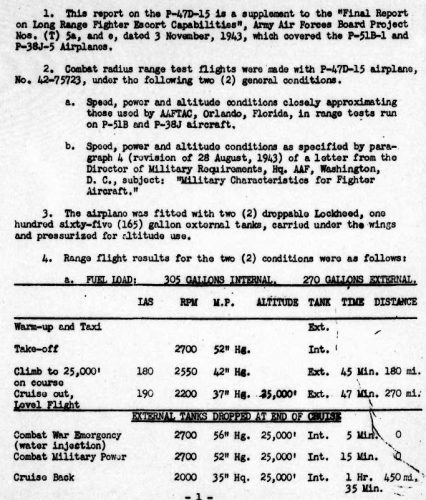
The photo above is from the shorter range 305 gallon internal fuel version of the P-47D available to the 8th Air Force in February 1944. There were also a number of the P–47D–25, with 370 gallons of internal fuel, available to 8th Air Force.
According to Joe Baugher, regards the P-47D-25 and P-47D-26 test variants without the extra internal fuel:
Ordinarily the AAF would have given such a radical modification as that which produced the bubble-canopy Thunderbolt a completely new variant letter, or perhaps even a new type number. However, they chose instead to simply give it a new production block number in the D-series. Consequently, the first batches to feature this new bubble canopy were Farmingdale’s P-47D-25-RE and Evansville’s P-47D-26-RA. Those batches also had the R-2800-59 or -63 engines, the paddle-bladed propeller, and the “universal” wing. Stronger belly shackles capable of carrying a 110-gal drop tank were fitted which, together with the 305-gal main fuselage tank, an 100-gal auxiliary fuel tank and two 150-gal underwing tanks, made possible a maximum range of 1,800 miles at 195 mph at 10,000′.
The usual way of determining “radius of action it to divide by 1/3. Joe Baugher‘s number above means a radius of action of 600 miles for the P-47D-25 with three drop tanks (one 110 gallon belly tank and two 150 gallon wing tanks) and the limited 305 gallon internal fuel tank.
A few weeks after Big Week, the USAAF conducted a series of tests at Eglin field to determine the ranges of the P-38L, P-47D-25 (with 370 gallon internal tanks) and P-51D-20 in escorting the B-29 for operations in the Pacific.
These were the results:
Army Air Force BoardFIGHTER COVER FOR VLR OPERATIONSPROJECT 03786C3731312 Mar 1945.III. CONCLUSIONS.-It is concluded that:.a. The employment of long range fighter aircraft as bombardmentescort in the Pacific Theater of Operations is feasible..b. The P-51D-20 aircraft, equipped with two (2) 75-gallon drop tanks and using recommended engine settings., has an 800-mile radius of action..c. The P–47D–25 aircraft, equipped with two (2) 165-gallon drop tanks and using recommended engine settings, has an 800-mile radius of action..d. The P-38J-5 and L aircraft, equipped with two (2) 165-gallon drop tanks and using recommended engine settings, has an 840-mile radius of action. Equipped with one (1) 300-gallon and one (1) 165-gallon drop tank, this aircraft has a radius of action of 950 miles wren the 165-gallon tank is retained over the target.
P-47N
900-mile radius of action
Full Internal Fuel
330 Gal External fuel (2×165 gal external tank)
.P-47N1050-mile radius of action
Full Internal Fuel
440 Gal External fuel (2×165 gal and one 110 Gal external tank).P-47N
1100-mile radius of action
Full internal fuel
630 Gal external fuel (2×310 gal drop tanks overloaded by 5-gal ea.)
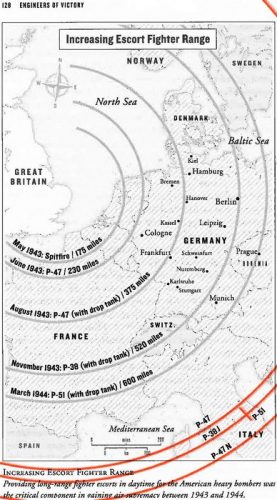
*Note: All of the above radii of action in the map are equivalent of VIIIth Fighter Command “target flight profiles” from the “three shift” fighter escort doctrine. That is, fighters were below 25,000 feet to burn up their external fuel tanks contents at “long of lean” fuel rating before they climbed to the 25,000 foot bomber stream altitude 1/2 hour from target.
So know you know how the Bomber Generals embedded their self-serving lies about the ETO fighter escort story into the historical record World War 2.
-End-
Have you read “BLOOD and FEARS” by Kevin Wilson on the bombing campaign?
“Big Week” continues with 799 aircraft dispatched ”¦
Just think about the manufacturing capacity the US had in the 1940s to allow daily continuing operations on that scale! Think ”¦ and weep.
The operating assumption today (especially among the “Buy the World a Coke” crowd) is that total war will never happen again. Even realists generally seem to assume that total war would mean nuclear Armageddon — all over in a couple of hours, end of story.
Some pessimists take the view that the fighting will not stop once the relatively small number of (hard to restock) high tech weapons are fired off — and the world finds out that nuclear war is not as totally destructive as the Loonie Left has claimed. Then we human beings will follow the same track as our ancestors. The Carthaginians did not stop fighting the Romans after the First Punic War, or even after the Second. The English did not stop fighting after the Blitz, nor did the Germans stop fighting after Dresden. After the brief nuclear holocaust, the survivors will carry on fighting with less high-tech (and more quickly constructed) weapons. Advantage China, with its massive industrial capacity!
The “free trade”/offshore all manufacturing crowd will end up with a lot of blood on their hands.
So, “history” is often the lies that have not been corrected. Thank-you for this corrective. The old narrative did not feel quite right.
>>So, “history” is often the lies that have not been corrected.
Got it in one.
>>Have you read “BLOOD and FEARS” by Kevin Wilson on the bombing campaign?
I’ve not gotten to it.
When I was a boy, I saw a movie about P 47 and drop tanks. It was “Fighter Squadron” and the story was about drop tanks.
1948. I was 10.
Mike K,
It’s posted in full on youtube right now, at least until the rights holder’s sends a letter to Google about that.
See here
Fighter Squadron Full Movie 1948
https://www.youtube.com/watch?v=kOiiSRHXkS8
“Video Unavailable.”
It Was the last movie I can remember my father going to.
I’ve updated this post with a photo of a 56th Fighter Group P-47 with a pair of UK built 108 gallon paper fuel tanks and a UK built 150 gallon belly tank.
The range of this P-47 drop tank combination was also left out of that 8th Air Force fighter escort radius of action map.